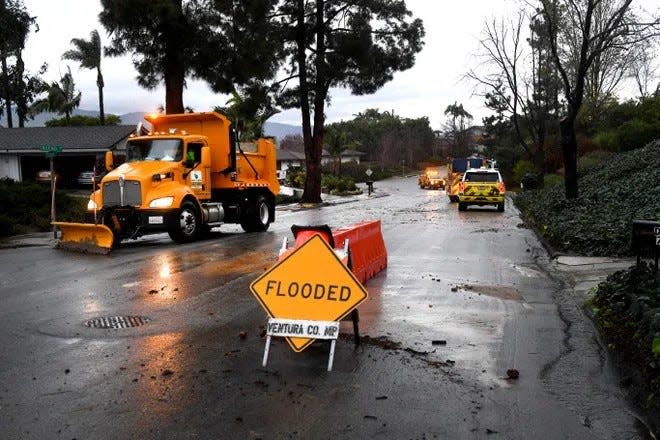'Pineapple Express' wallops California, dumping heavy rain and snow
An atmospheric river, also known as a "Pineapple Express," continued to slam into California on Thursday, pounding the state with heavy rain and snow and triggering road closures and rockslides. It's the first of two storms forecast to wallop California over the next few days with periods of rain, snow, wind and flooding.
A second atmospheric river, which meteorologists said could be much stronger than the first storm, was expected to barrel into California on Sunday and into Monday.
"There has been some flooding from today's storm across parts of SoCal (especially in/near Long Beach), but the Sun-Tue system has *much greater* potential for more widespread and more serious flooding/debris flows in SoCal," Daniel Swain, a climate scientist at the University of California, Los Angeles, said on X, formerly Twitter.
Impacts from the pair of storms include travel troubles, mudslides, power issues, coastal erosion and property damage.
Much of Northern California received 1 to 4 inches of rain from the first storm into Thursday morning, according to AccuWeather. By the Thursday night, AccuWeather said the "bulk of the rain" ended for San Francisco and Sacramento.
Drier air will reduce the rain and mountain snow through Thursday night and Friday, according to AccuWeather. But residents in Southern California from Los Angeles to San Diego, may still encounter travel difficulties into night as the worst of the rain moves inland.
Southern California faces heavy rain, flash flooding
The first storm hit the San Francisco Bay Area on Wednesday and moved south on Thursday, arriving in Los Angeles just in time to snarl the morning commute. The river of rain “will be taking aim at mostly Southern California” on Thursday, National Weather Service forecaster Bob Oravec said.
The heavy rain was forecast to create mainly localized areas of flash flooding, with urban areas, roads, small streams, and burn scars the most vulnerable, the weather service warned.
Parts of Los Angeles County on Thursday were impacted by flash flooding causing drivers to travel through low-lying roads filled with water. In Seal Beach, a coastal city in Orange County just south of Los Angeles, there was also flooding along the Pacific Coast Highway that caused parts of the freeway to close.
In Costa Mesa, California, a swift-water rescue team pulled someone from a storm channel that had filled up with rainwater. The person was taken to hospital in stable condition, the Orange County Fire Authority said on X, formerly Twitter.
The fire authority also rescued a man who was trapped on a small island in the Santa Ana riverbed, surrounded by rushing water. A paramedic had to be lowered by a helicopter to rescue the man.
The storm – which some forecasters likened to "a giant firehose" – was expected to move south through California on Thursday night before shifting inland over the Southwest from Friday to Saturday, AccuWeather said.
By Thursday afternoon, the weather service said the main band of rain had moved through eastern San Diego County. Occasional rain showers occurred through the day and winds will continue Friday with the strongest over the mountain crests and desert slopes.
According to the weather service in Los Angeles, 5 daily rainfall records — which were had been set between 1940 to 1960 — were broken across the region on Thursday.
A record daily rainfall of 2.37 inches was set at Los Angeles Airport, breaking the old record of 1.55 inches in 1960. The Santa Barbara Airport saw 2.93 inches of rainfall, also breaking the old record of 2.02 inches set in 1960.

What is the Pineapple Express?
This storm is being referred to as a Pineapple Express, the most well-known nickname for an atmospheric river, which occurs when the source of the moisture is near Hawaii. When a Pineapple Express hits land in the western United States and Canada, it can cause heavy rain and snow. In California, it can cause several inches of rain in a day.
Photos from the storm: See how the rain is affecting Ventura County Thursday
Up to 4 feet of snow for the mountains
Sierra Nevada snow levels are expected to lower throughout the day on Thursday and into Friday. According to AccuWeather, motorists are likely to see difficult travel over Donner Pass, California, as snow continues through Thursday night before tapering to snow showers on Friday.
The Mammoth Mountain ski resort in the Sierra Nevada reported 12 to 14 inches of snow overnight. Heavy snowfall was also recorded in the mountains east of Los Angeles.
A winter storm warning was in effect through Friday morning for the Sierra Nevada, from north of Lake Tahoe to south of Yosemite National Park, said the weather service office in Reno, Nevada. Snowfall rates of up to 2 inches per hour were forecast for some areas, with winds gusting at up to 100 mph.
'Stronger' storm on the way
The second storm in the series has the potential to be much stronger, according to Swain. According to Weather.com, the storm has the potential to bring flooding rain, landslides and rockslides as well as mountain snow and strong winds.
AccuWeather senior meteorologist Day Pydynowski said, "The second storm originated from near Hawaii and is likely to have a true plume of tropical moisture associated with it."
In addition, due to the cumulative impacts from the two storms, travel and flooding problems from the second storm may be more extensive and much worse than those from the first storm, AccuWeather warned.
Contributing: The Associated Press
This article originally appeared on USA TODAY: First 'Pineapple Express' dumps massive rain into California: Updates
